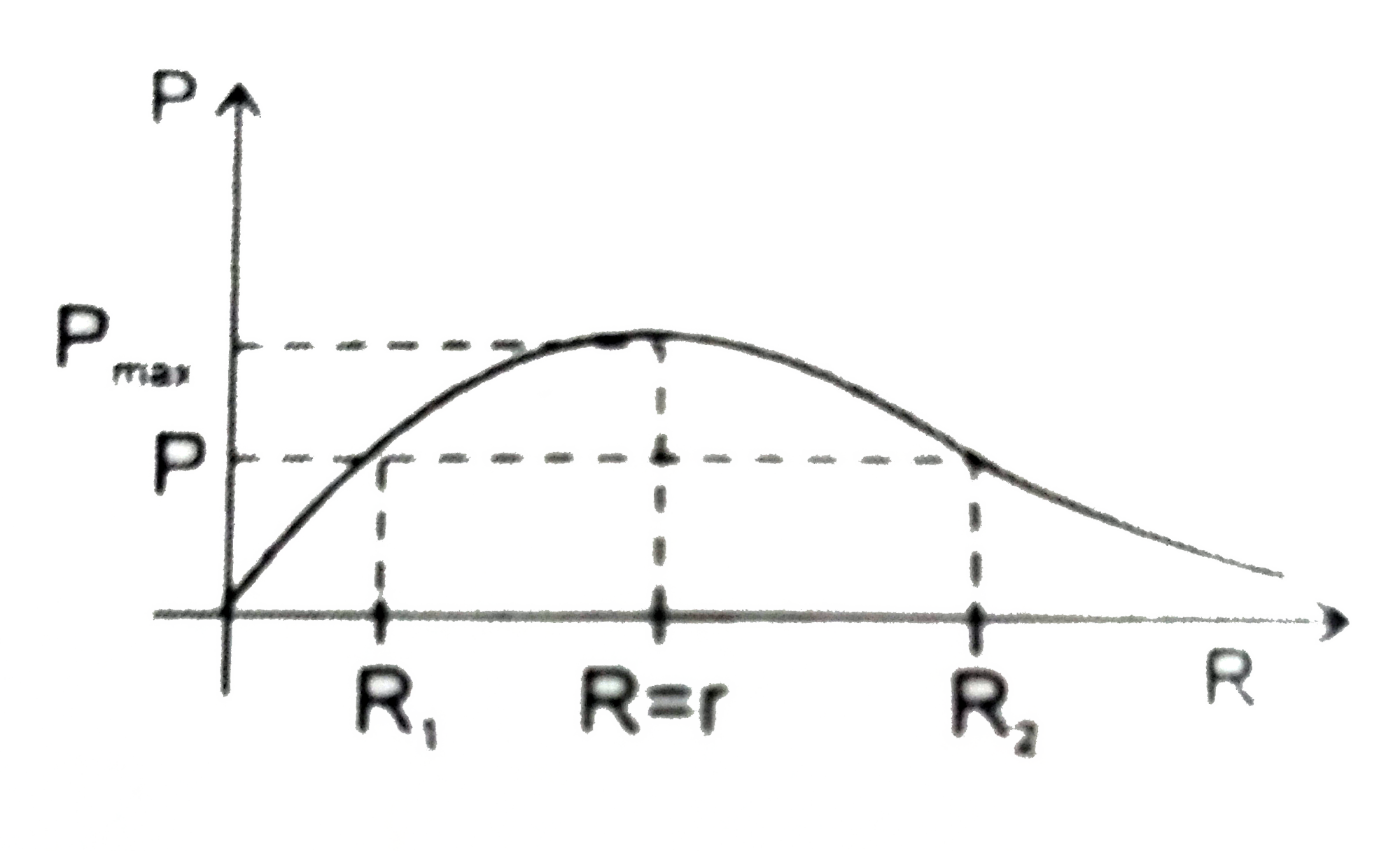A body of mass 10 kg and velocity 10 m/s collides with a stationary body of mass 5 kg . After collision both bodies stick to each other , velocity of the bodies after collision will be
a) 3 /10 m/s
b) 18 /3 m/s
c) 9 /2 0 m/s
d) 20 /3 m/s
(a) In the circuit shown if we assume that potential at A is zero then potential at A is zero then potential at B is ε−ir. Now since the connecting wires are of zero resistance
∴VD=VA=0⇒VC=BB=ε−ri
Now current through CD is also i (because it's in series with the cell).
∴i=VC−VDR=(ε−ir)−0R Current i=εr+R
Note : After learning the concept of series combination we will be able to calculate the current directly
(b) Power output P=i2R=ε2(r+R)2R
( c) dpdR=ε2(r+R)2−2ε2R(r+R)3[R+r−2R]

for maximum power supply dpdR=0
⇒r+R−2R=0⇒r=R
Here for maximum power output outer resistance should be equal to internal resistance
(d) Pmax=ε24r
( e) Graph between 'P' and R maximum power output at R=r
Pmax=ε24r⇒i=εr+R
(f) Power output P=ε3R(r+R)2
P(r2+2rR+R2)=ε2R
R2+(2r−ε2P)R+r2=0
Above quadratic equation in R has two roots R1 and R2 for given values of ε, P and r such that
∴R1R2=r2(product of roots)
r2=R1R2
(g) Power of battery spent =ε2(r+)2,2r=ε32r
Power (output)=(εr+r)2×r=ε24r
Efficiency =Power outputtotal power by cell=ε24r×100ε22r=12×100=50%
Topper's Solved these Questions
- CURRENT ELECTRICITYBOOK - RESONANCE ENGLISHCHAPTER - CURRENT ELECTRICITYEXERCISE - Solued miscellaneous Prolblems
8 Videos
- CURRENT ELECTRICITYBOOK - RESONANCE ENGLISHCHAPTER - CURRENT ELECTRICITYEXERCISE - Exercise-1 (Part-1)
41 Videos
- COMMUNICATION SYSTEMSBOOK - RESONANCE ENGLISHCHAPTER - COMMUNICATION SYSTEMSEXERCISE - Exercise 3
13 Videos
- DAILY PRACTICE PROBLEMBOOK - RESONANCE ENGLISHCHAPTER - DAILY PRACTICE PROBLEMEXERCISE - DPP.No.71
1 Video
Similar Questions
A body of mass 2 kg moving with a velocity of 3 m/sec collides head on with a body of mass 1 kg moving in opposite direction with a velocity of 4 m/sec. After collision, two bodies stick together and move with a common velocity which in m/sec is equal to
View SolutionA body of mass 10 kg moving with speed of 3ms−1 collides with another stationary body of mass 5 kg As a result, the two bodies stick togethre. The KE of composite mass will be
View Solution
Knowledge Check
A ball weighing 4 kg and moving with velocity of 8 m/sec. Collides with a stationary ball of mass 12 kg. After the collision, the two balls move together. The final velocity is
A0B2 m/secC8 m/secD16 m/sec
A body of mass 4kg moving with velocity 12m/s collides with another body of mass 6kg at rest. If two bodies stick together after collision , then the loss of kinetic energy of system is
View SolutionA body of mass 4kg moving with velocity 12m/s collides with another body of mass 6kg at rest. If two bodies stick together after collision , then the loss of kinetic energy of system is
View SolutionA body of mass 3kg moving with a velocity of 4m/s towards left collides head on with a body of mass 4kg moving in opposite direction with a velocity of 3m/s. After collision the two bodies stick together and move with a common velocity which is
View SolutionA body of mass m1 moving with a velocity 3m/s collides with another body at rest of m2 . After collision the velocities of the two bodies are 2m/s and 5m/s , respectively , along the direction of motion of m1. The ratio m1/m2 is
View SolutionA body of mass m moving with velocity 3km/h collides with a body of mass 2m at rest. Now, the combined mass starts to move with a velocity
View SolutionA ball of mass 1 kg moving with a velocity of 0.4 ms−1 collides with another stationary ball. After the collision, the first ball moves with a velocity of 0.3ms1 in a direction making an angle of 90∘ with its initial direction. The momentum of the second ball after the collision will be (in kg ms−1)
View SolutionA body of mass m moving with a constant velocity collides head on with another stationary body of same mass if the coefficient of restitution between the bodies is 12 then ratio of velocities of two bodies after collision with be
View Solution
